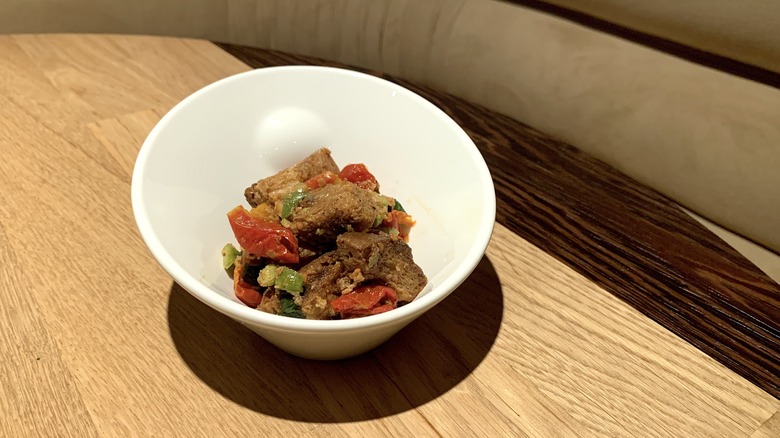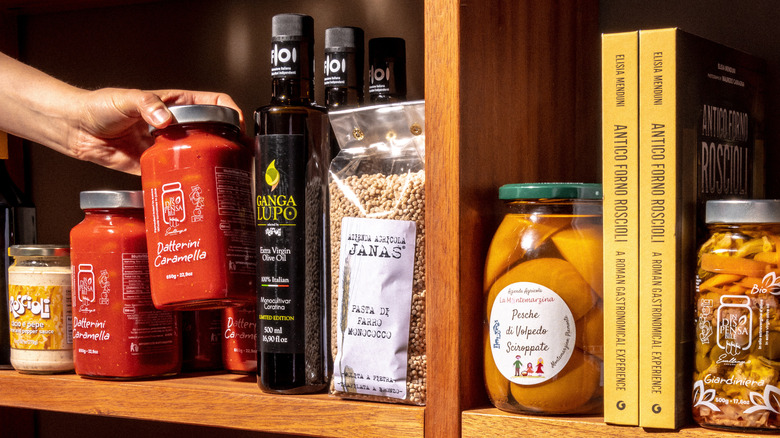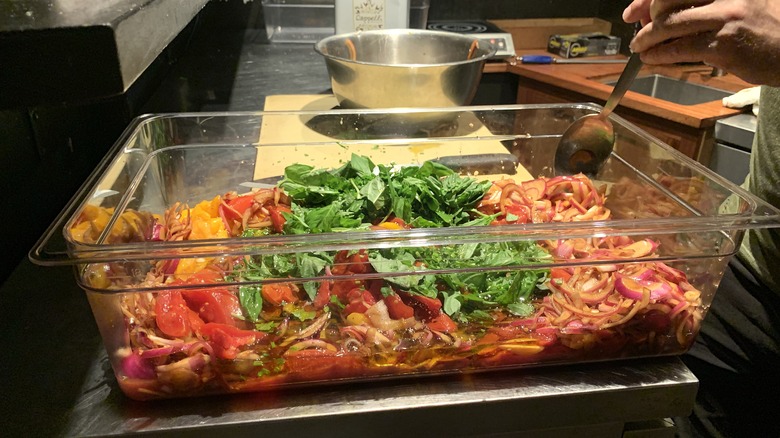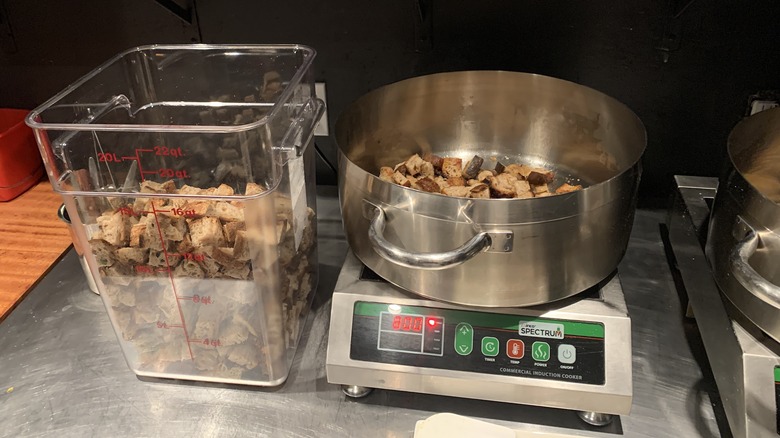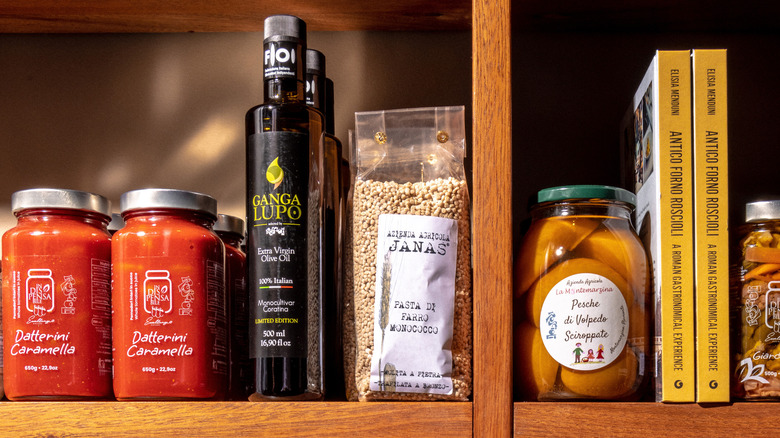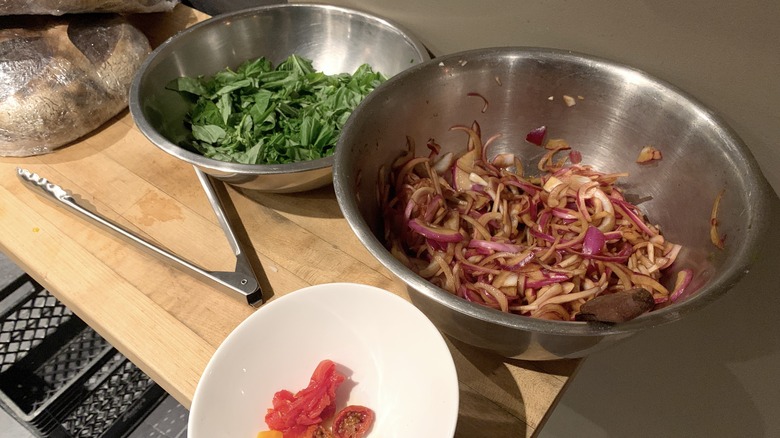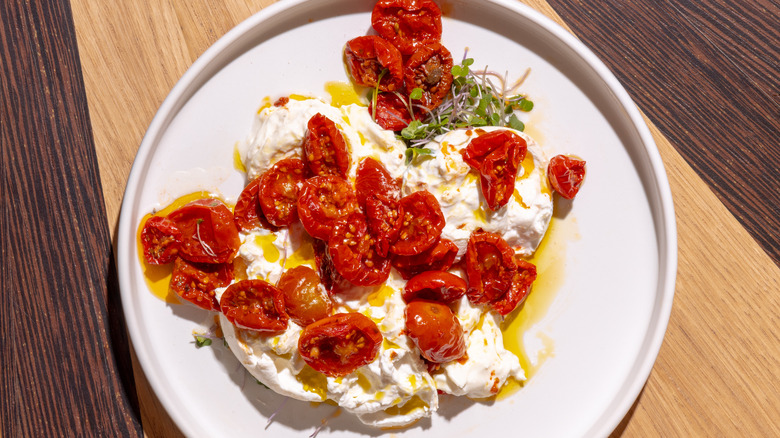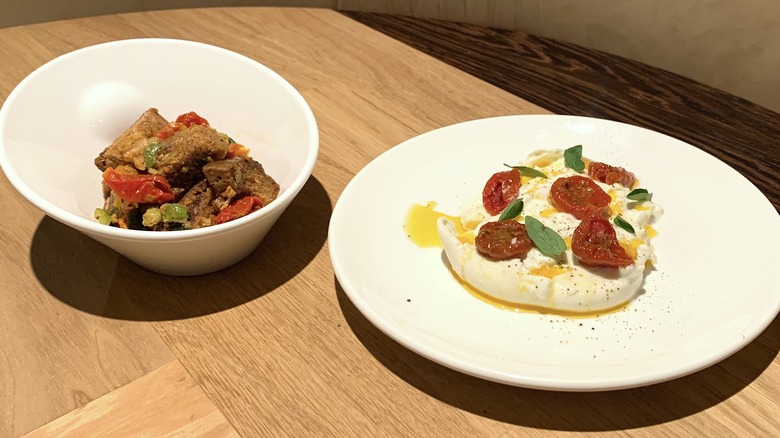How Hot Spot Roscioli NYC Makes The Perfect Panzanella Salad
Panzanella's simplicity has allowed cooks for centuries — and now the chefs at Roscioli NYC — to create a satisfying dish that speaks to warm weather, long days, and premium ingredients. In essence, panzanella salad is a humble Italian dish made with stale bread, tomatoes, onions, basil, and liberal amounts of olive oil. The first establishment located outside of Rome for the celebrated family of restauranteurs, Roscioli NYC hosts two nightly seatings for its tasting menu, welcoming visitors with panzanella salad as the first course.
We arrived at the new location at the confluence of Greenwich Village and Soho to see exterior windows still obscured by brown shipping paper. The main floor at Roscioli NYC is expected to open in September as a bright salumeria on a quaint, brick-lined wedge of MacDougal and King streets. For now, guests enter and dine in the cellar, which feels more like an Italian villa than the standard New York basement.
The Roscioli team took over the former Niche Niche space in partnership with Ariel Arce, also behind the nearby Tokyo Record Bar. We spent the morning at Roscioli NYC, speaking with former Niche Niche chef Aaron Lirette and the culinary team under the lead of chef Tommaso Fratini (who happened to be back in Rome during our visit). We learned what makes this dish special and how to make an elevated panzanella the Roscioli way — so you can, too.
Start with quality ingredients
Roscioli's reputation for sourcing superior ingredients is in no small part why this NYC restaurant is one of the most sought-after reservations in the city. The Roscioli brand is a family business synonymous with simple Italian dishes made from quality ingredients. It all started in 1974 with Antico Forno Roscioli, located in one of the oldest bakeries in Rome, which expanded to Salumeria Roscioli, a deli-turned-restaurant known for attracting lines out the door. The team opened the NYC property as its first location outside of Italy to continue this tradition of a deli and restaurant focused on Italian dishes that would make your nonna proud.
Chef Aaron Lirette explains that Roscioli NYC's panzanella uses a mixture of ingredients flown in from Italy but also includes a variety of tomatoes and items sourced from local vendors. "Good ingredients, good bread, good tomatoes," he tells us. "It's all simple stuff, but it's the best." We're told that the Roscioli NYC team often visits the local market for fresh ingredients but has also managed to seek out local sources, including burrata made in New York state.
Alessandro Pepe, who leads the wine program at Roscioli NYC and founded its Roman counterpart, explains that somewhere, many restaurants have forgotten the basics. He tells us how "Alessandro [Roscioli] used to say 'spaghetti with tomatoes is the hardest dish to make.'" Pepe says the NYC restaurant aims to "go back to the simple stuff."
Add multiple types of tomatoes
A panzanella salad is "one of the most important summer plates," explains Chef Luca Rosso, who is visiting from Rome to contribute to the culinary team. He tells us with a smile that you "can bring a plate for the beach." The ancient dish started as a way for farmers to use surplus summer vegetables. Avoiding waste turned into a beloved and light meal with tomatoes as the star of the plate.
The Roscioli NYC team uses four different types of jarred and fresh tomatoes to create an exceptionally balanced flavor. Rosso lined up jars of vibrant imported fruits, including Calabrian tomatoes cut in half lengthwise and preserved pacchetelle style. Sweet Puglian cherry tomatoes are semi-dried and preserved in olive oil, a true highlight of the first course. It's the type of flavor that lingers after the brightness of other tart vegetables fade. Chef Aaron Lirette explains the roasted cherry tomatoes only build in sweetness, "like candy."
The chefs toss a mix of tomatoes with herbs, aromatics, and olive oil as part of the morning routine. It's the bread, however, that makes the vegetable medley a true meal.
Toast day-old bread for more flavor
It's usual to use bread up to 10 days old, explains Chef Luca Rosso, who is currently baking bread for the restaurant. (It's no small task to do so for a brand famed for baking bread in a 200-year-old oven). The team can put day-old bread to proper use, but Chef Aaron Lirette clarifies that there is not always much left over at the end of a shift. Instead, fresh and older bread alike is broken into cubes and lightly toasted in olive oil to reach a firm texture. Cooks at home can rescue a forgotten baguette or employ the same technique to toast bread that might not be crusty enough to hold its shape. You want the bread to maintain a solid chew even after soaking and being moistened by the tomatoes.
Alessandro Pepe, who is Roscioli's sommelier and an Italian import himself, tells us that there is a version of panzanella bread that is "maybe two weeks old" and is soaked in water so that it "doesn't fall apart but becomes soft" to maintain its shape in the mixture. Regionally, panzanella is known to be made with different techniques. Tuscan or Umbrian panzanella bread is soaked until wet, then squeezed dry and crumbled. In northeastern Le Marche, wet bread is used as a foundation for the other ingredients, similar to bruschetta.
"Grandma, when she made panzanella, it was really to get rid of old ingredients," Pepe says. "For me, it's my childhood."
Use plenty of robust olive oil
Panzanella requires plenty of rich olive oil. Chef Aaron Lirette says the restaurant may change what type or brand of olive oil it uses, but "any high quality" oil will do when making the dish at home. The unanimous recommendation from the team is to use Italian olive oil. Russo went further by specifying, "for sure an olive oil from the south of Italy because it's more strong than the north."
Alessandro Pepe agrees, in part, because styles from the south are often much bolder and nuttier — and "panzanella needs a strong olive oil." He explains the best olive oil is in Puglia, the southeast region of Italy famous for producing oil for thousands of years and, coincidentally, where the sommelier hails from. All that said, finding fresh and flavorful olive oil in the United States can be hard.
Pepe explains that most olive oil can lose a lot of flavor in the first six to eight months, but oil from Puglia can retain flavor for up to one year. He says Puglia olive is "very strong" due to the "density and the nuttiness," so not all chefs love to use it. Consider buying a bottle of finishing olive oil, and don't be afraid to use it.
Add aromatics (and a bit of patience)
Aromatics and herbs round out the panzanella course at Roscioli NYC. Tradition calls for basil, onion, and black pepper, and the team takes it a step further by adding capers, olives, and balsamic vinegar. Chef Aaron Lirette tells us to use purple onions, which are chopped and marinated in balsamic at the restaurant. Purple onions, also known as red onions, bring a sharp heat to a dish and add a beautiful color. Seek out an Italian purple onion, which is typically sweeter and contains less sulfur than other varieties. Of course, stay on theme by including what is available, even if a yellow onion or scallion is all you can work with.
Mix the fresh basil, chives, green and black olives, and purple onions with your chopped or halved tomatoes. Add an ample amount of olive oil. You'll want flavors to meld, but avoid mashing together the individual ingredients. Chef Lirette says it's important to let the mixture of aromatics and vegetables sit and marinate for at least six hours. He explains you can also let it sit in the fridge overnight or for a couple of days. Similar to a pico de gallo recipe, the juices all need to marinate.
Pair the panzanella with burrata
The Roman import has outdone itself by pairing its panzanella course with a plate of burrata, a healthy portion of fresh cheese drizzled with olive oil and topped with the same semi-dried Puglian tomatoes in the panzanella. The rich yet mild cheese adds depth to the light bread salad. Italian burrata isn't found stateside, however, because it is traditionally made with raw milk. More importantly, such a creamy and delicate cheese is difficult to transport. Chef Aaron Lirette says that Roscioli NYC sources burrata made with New York milk from the Chef's Collective, an artisan co-op that mainly produces items for restaurants. He also explains they're "some of the only people who have this."
"Burrata was one of the biggest issues when opening the restaurant," says Alessandro Pepe. "The shelf life is maybe four hours." After exploring more expensive options, he says the team found locals to create a version with cow's milk, made in the morning for the restaurant. According to Pepe, Roscioli NYC is also working with the collective to increase the milk fat for a richer product.
The Roscioli NYC tasting menu delivers one panzanella per person with a shared plate of burrata for every two. We managed to eat almost the entire plate (it's that good). It'll be hard to pace yourself if partaking in the multi-course tasting menu. We suspect this dish might be one of the highlights of the á la carte menu when it's open to the public.
Experiment at home with panzanella ingredients
Panzanella is often referred to as peasant food because it is a meal made of necessity. Families didn't want to waste old bread and might mix it with vegetables straight from the garden — not quite an ancient struggle meal but a way to avoid food waste that can be appreciated today.
For home cooks, you can add whichever herbs and vegetables that are sitting in the fridge or on the counter. Chef Aaron Lirette suggests including the traditional cucumber or other abundant summer vegetables like zucchini. Chef Luca Rosso says tomatoes and onions are the most important ingredients for flavor, so you might want to focus on securing fresh purple onion and heirloom tomatoes from your local market when in season. We love the hint of sweetness found in yellow and gold heirlooms. Otherwise, you can find jars of semi-dried and pacchetella-style year-round, similar to the approach at Roscioli NYC.
You can also source burrata to complete the meal. We recommend investing in cold-pressed extra virgin olive oil made with olives from a single country. Although Italian is ideal, look for a brand that indicates the harvest date on the bottle; a date harvested in the same year is more likely to have retained its flavor.
